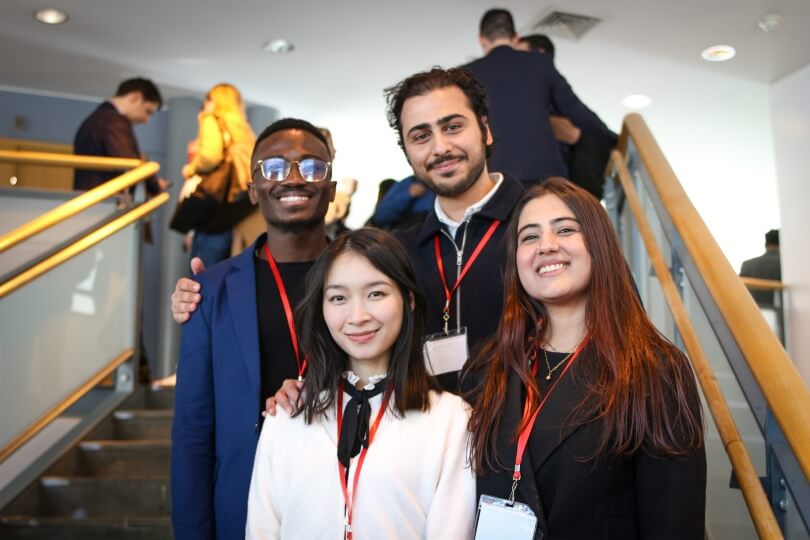News
Enlight co-founders Joachim Asare, Sangyu Xi, Hessan Sedaghat and Prachi Mehta at the MIT Sloan Product Conference.
Screen readers are a standard tool for visually impaired people but they have limitations. A screen reader can recognize static text and alternate text to describe images, but can’t recognize or explain interactive or dynamic graphics based on inputted data, such as graphs and tables. This poses a major challenge for any visually impaired person doing data analytics.
“Nearly 96 percent of websites aren’t developed with accessibility features, so even screen readers hardly work, and users lose out on contextual understanding,” said Joachim Asare, a Master in Design Engineering (MDE) student at the Harvard John A. Paulson School of Engineering and Applied Sciences (SEAS) and Harvard Graduate School of Design. “One major downfall especially is with complex data. A screen reader can’t really interpret a graph, because the HTML code doesn’t see it.”
Asare and fellow MDE students Hessan Sedaghat, Sangyu Xi and Prachi Mehta have spent the last six months developing Enlight, a new browser extension to help the visually impaired access and interact with web analytics and dynamic graphics. Enlight uses large language models and machine learning to interpret data analytics, then suggests questions to the user that it can answer from the data. For example, Enlight could look at online data about product sales in a given month, then answer questions about which products sold the most.
The current target market is visually impaired business owners and managers, but Enlight could be adapted for other uses in the future.
“We can also expand this into education for data science or business majors,” Xi said. “For visually impaired students, this can be a powerful tool for understanding what’s going on. Even if you can see the data, you might not understand what’s going on, and this tool is there to help with that.”
Prototyping for Enlight began this spring during a core class in the MDE program. Initially the plan was to design a cash flow management application, but the team quickly realized there were many such applications already on the market, and they wouldn’t be able to design something better than what was already available.
“We found that with one app, there was a comment from a visually impaired business owner who couldn’t use the app because there were no accessibility features,” Xi said. “These are people who could really use help, because small businesses tend to employ the majority of the disabled workforce. If we could design something for them, that would really help them thrive.”
The team decided to develop a product to address that gap.
They credited faculty such as Andrew Witt, MDE Director and Associate Professor in Practice of Architecture, and Kathleen Brandenburg, Design Critic in Architecture, for their continuous guidance to help get the product out of its early stages. They also reached out to assistive technology leaders such as Joshua Miele, an accessibility researcher at Amazon focused on low vision and blindness, and Matt Ater, vice president of Vispero, one of the biggest assistive technology providers for the visually impaired.
“Our master’s program brings together people from various backgrounds,” Asare said. “Sangyu came from a product management and industrial engineering background, Hessan has a robotics background, and Prachi and I came from a software and computer science background. That kind of diversity helped us develop a well-balanced group.”
The team launched Enlight at the MIT Sloan Product Conference where they placed third out of 30 teams in the pitch competition.
“We talked about our idea and showed our prototype, business model, revenue model, go-to-market strategy, and our user validation,” Xi said. “Before we pitched, we’d already validated the idea with thought leaders in assistive technology at Amazon and JAWS, which is one of the most popular screen reader programs. That made us really stand out in a short period of time, and told the world that this was something really unique.”
The four teammates have separated for the summer as they all pursue work or internship opportunities. But even when separated by distance, they continue to work on refining Enlight into something that could soon be available for widespread use.
“We have a larger consumer market that would also eventually benefit from this,” Asare said. “We believe that anything designed for accessibility is useful for everyone.”
Topics: AI / Machine Learning, Computer Science, Design, Entrepreneurship
Cutting-edge science delivered direct to your inbox.
Join the Harvard SEAS mailing list.
Press Contact
Matt Goisman | mgoisman@g.harvard.edu



